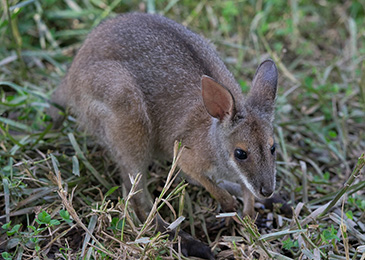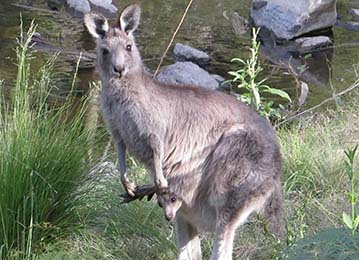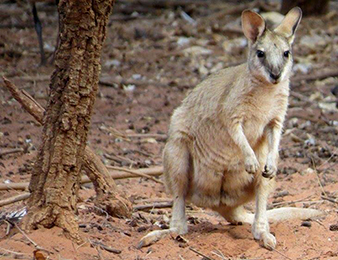MACROPODS
The Epic Tale of Australia’s Macropods
In the heart of Australia’s wild landscapes, a unique cast of mammals—known as macropods—brings the bush to life with every bound and leap. Their story is not just about survival, but about the intricate dance of adaptation and resilience that has shaped them into the icons of Australia’s natural heritage.
Meet the Macropods: Families
| Family | Key Members | Typical Habitat | Body Size |
|---|---|---|---|
| Macropodidae | Kangaroos, Wallabies, Pademelons, Tree kangaroos | Grasslands, forests, trees | Up to 2.5 m |
| Potoroidae | Potoroos, Bettongs, Rat kangaroos | Forests, scrub, undergrowth | Up to 1 m |
A Study in Contrasts
- Kangaroos: Towering figures of the open plains, sometimes reaching 2.5 metres in height. They are built for speed and distance, with elongated hind legs and robust tails.
- Potoroids: Smaller, secretive creatures adapted for life amidst dense vegetation, rarely growing beyond a metre.
- Wallabies and Relatives: Navigators of forests and rocky outcrops, moving with a blend of hops and cautious steps.
Adaptations: Masters of Movement
Imagine the early morning hush, dew clinging to grass as a kangaroo mob stirs. Powerful hind legs coil and release, launching bodies in high, graceful arcs. Their tails, thick and muscular, act as balancing poles, guiding their course with each bound.
- Auditory: The rhythmic thud of feet on earth echoes across the plains.
- Visual: Sunlight catches on grey and russet fur as animals weave through golden grass.
- Tactile: The rough texture of bark, the cool brush of leaves, as smaller potoroids burrow and forage.
Diet: A Botanical Banquet
- Kangaroos: Specialise in tough, fibrous grasses, chewing methodically as the sun beats down.
- Wallabies and Tree Kangaroos: Enjoy a varied menu—leaves, fruits, and tender shoots, sampling the aromatic diversity of the bush.
- Potoroids: Forage for fungi, roots, and tubers beneath the forest floor, playing a hidden but vital role in seed dispersal and soil health.
Social Life: Mobs and Solitude
- Kangaroos: Social animals, forming large groups (mobs) where social hierarchies and interactions play out with subtle glances and postures.
- Wallabies and Potoroids: Prefer solitude or small family units, blending into the undergrowth, their presence marked only by the soft rustle of leaves.
Challenges and Change
Australia’s macropods have faced profound changes since European settlement:
- Predators: Foxes, cats, and dogs have altered the balance, preying on the smallest and most vulnerable species.
- Habitat Loss: Competing with livestock, macropods are pushed from traditional grazing lands.
- Fire Regimes: Changed bushfire patterns have transformed their habitats, making survival ever more challenging.
Conservation Insight:
Today, only 15 of the original 21 species in New South Wales remain. The smallest macropods, with their specialised needs, are most at risk.
Macropods and Their Remarkable Reproduction
Macropods – the group that includes kangaroos, wallabies, wallaroos, pademelons and tree-kangaroos – have one of the most unusual and finely tuned reproductive systems of any mammals on Earth. What looks simple from the outside – a joey peeking from a pouch – is actually the visible tip of a very complex strategy shaped by millions of years of evolution in Australia’s often harsh and unpredictable environments.
Tiny Birth, Huge Journey
Macropods are marsupials, so their young are born at a very early stage of development. Pregnancy is extremely short compared with most placental mammals. In many macropod species, gestation lasts roughly a month. At birth, the joey is blind, hairless, and only a few centimetres long, weighing less than a gram in some smaller species.
Yet the most dramatic part of its early life happens in the first few minutes. After birth, the joey must make its own way from the mother’s birth opening to the pouch. It uses its forelimbs, already relatively well developed, to climb through her fur, guided by instinct and scent. This journey might only be a few centimetres, but for such a tiny creature it is a marathon of survival. Once it reaches the pouch, it firmly attaches to a teat, which then swells in its mouth and helps to hold it in place.
At this point, the joey is still extremely fragile. Its eyes are closed, its organs are unfinished, and much of its development will now happen inside the pouch rather than in the womb, as it would in placental mammals.
The Pouch: A Mobile Nursery
The pouch, or marsupium is one of the defining features of macropods. It is much more than a simple pocket of skin. It functions as a climate-controlled nursery, a safe place for early development while the mother continues to move, graze, and avoid predators.
Inside, the pouch lining is soft, lightly haired and warm, creating a protected microclimate. The joey spends months in this space, attached to a teat and feeding on milk that is specially tailored to its developmental stage. In larger macropods such as kangaroos and wallabies, the joey stays fully in the pouch for many months before it begins to peek out, then venture briefly outside, and finally leave the pouch for good. Even after that, it returns to suckle and will stay close by its mother for a long period.
Embryonic Diapause: Pausing Life Mid-Stream
One of the most fascinating reproductive tricks in many macropods is embryonic diapause – the ability to pause the development of an embryo.
In species such as kangaroos and most wallabies, a female can mate and conceive even while she already has a joey in the pouch. Instead of allowing the new embryo to continue developing, her body can place it into a suspended state. The embryo remains alive, but its development is effectively put on hold.
This pause can last for weeks or months, depending on the species and conditions. When the pouch joey vacates the pouch or stops suckling as intensely, hormonal signals tell the dormant embryo to resume development. It then continues a short gestation and is born, beginning the journey to the pouch just as its older sibling becomes more independent.
This means that a single female macropod can have:
- A large juvenile at foot, grazing but still occasionally suckling
- A younger joey in the pouch
- A paused embryo in the uterus waiting for the right moment to develop
This layered system allows macropods to time births to match food availability, rainfall and body condition. In Australia, where droughts and unpredictable seasons are common, this flexibility is a major survival advantage.
Milk That Changes with the Joey
Another remarkable feature of macropod reproduction is the way their milk composition changes as the joey grows. Early milk is more dilute and suited to a very young, rapidly developing joey. Later milk becomes richer and higher in fats and different proteins, meeting the needs of a more active youngster.
In most kangaroos and wallabies, a mother can produce two different types of milk at once from different teats. One teat provides early-stage milk for a tiny joey in the pouch, while another produces later-stage milk for an older joey that has left the pouch but still comes back to suckle. This ability to fine-tune nutrition allows the mother to support multiple offspring of different ages at the same time.
Extended Parental Care
Macropods invest heavily in long-term care rather than in giving birth to many fully independent young. Although gestation is short, the period of pouch life and post-pouch dependence is long. In many species, it takes more than a year from birth until a young animal is largely independent.
During this time, the young learn:
- What to eat and where to find it
- How to respond to threats and follow the mob’s movements
- Social behaviours such as grooming, play, and recognising dominance signals
This extended learning period gives them the skills they need to survive in complex, changing landscapes.
Variation Across the Macropod Family
While these patterns are common, there is a great deal of variation among macropods:
- Kangaroos and large wallabies tend to show strongly developed embryonic diapause and long periods of pouch life and care.
- Smaller wallabies and pademelons may have shorter pouch periods, but their young are still born at an extremely undeveloped stage and rely on the pouch nursery.
- Tree-kangaroos, adapted to rainforest canopies, follow the same basic marsupial system of short gestation, pouch development and changing milk, but their young eventually learn to climb among branches rather than hop across open ground.
Despite these differences, the fundamental pattern remains: very early birth, prolonged pouch development, flexible reproduction, and milk that changes to match the joey’s needs.
Why This System Works So Well
Macropods evolved in environments where food supply can shift quickly and unpredictably. Their reproductive system reflects this:
- Short gestation means a relatively low energy cost of pregnancy.
- The pouch allows mothers to stay mobile and responsive to danger or changing food sources while still caring for very vulnerable young.
- Embryonic diapause and staggered young allow females to take advantage of good seasons, yet slow or pause reproduction in harsh times.
- Extended care, with tailored milk and long learning periods, gives each joey a strong chance of survival once it finally becomes independent.
This intricate system is one of the reasons macropods have been so successful across a wide range of Australian landscapes – from dry inland plains to coastal forests and tropical rainforests.
Understanding how unique and finely balanced macropod reproduction is also highlights how important it is to protect their habitats. Their entire life cycle depends on having safe feeding grounds, room to move, and reliable food and water. When those are conserved, these remarkable animals can continue their quiet, complex dance of life across Australia’s wild landscapes.
The Spirit of Resilience
Through drought, fire, and change, macropods endure, embodying the spirit and adaptability of the Australian bush. Their story is not only one of survival, but also of intricate relationships—between animal, plant, landscape, and people.
A Call to Action
As we marvel at the macropod’s boundless energy and quiet determination, we are reminded of our own role in the story. Every action to protect their habitats, manage invasive predators, and restore balance is a step towards preserving the living tapestry of Australia’s wild heart.
Australia’s macropods are more than just creatures of legend—they are living symbols of resilience and diversity. Their future depends on all of us. By learning their story and sharing in their wonder, we help safeguard the vibrant chorus of life that echoes across the bush, for generations to come.



























